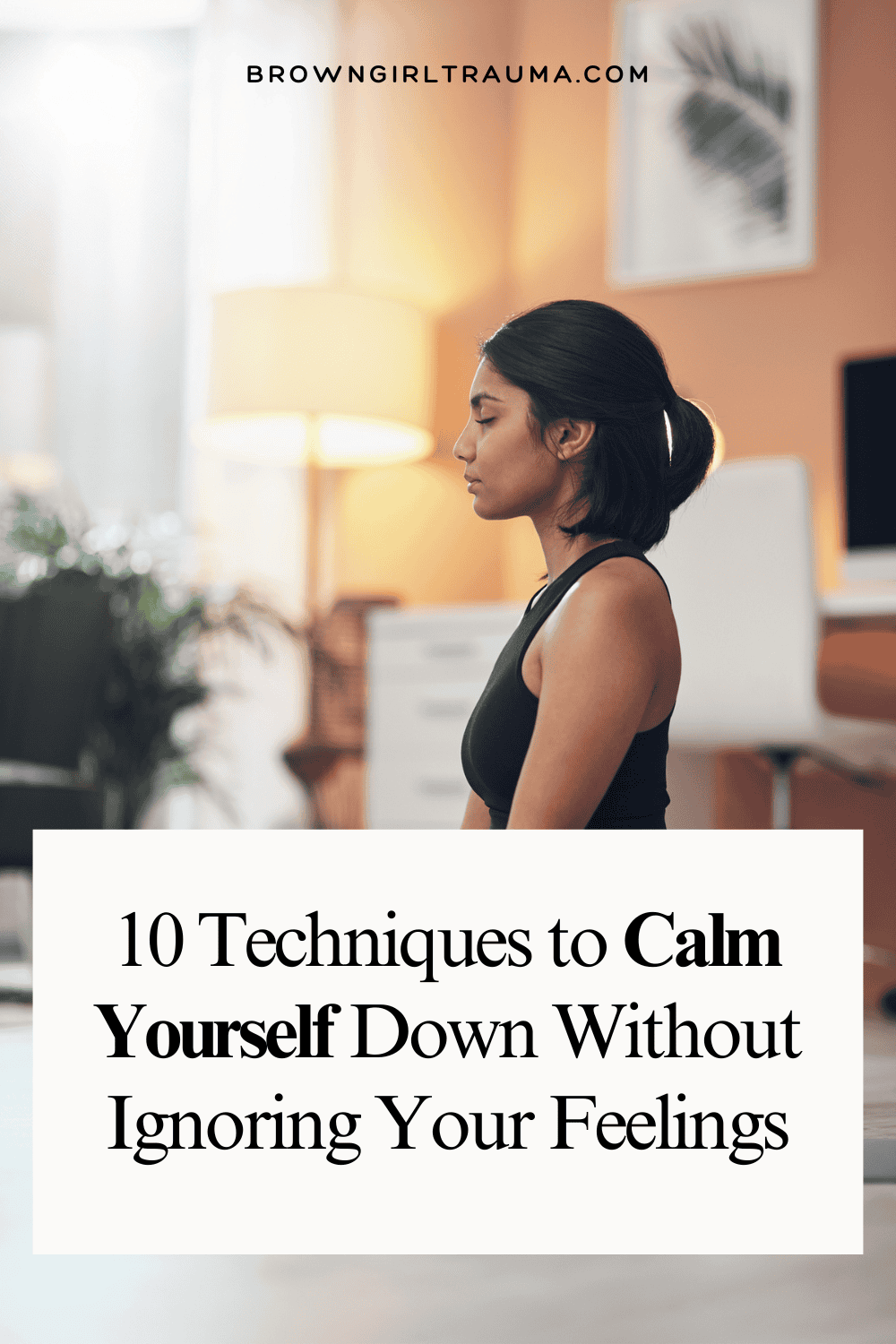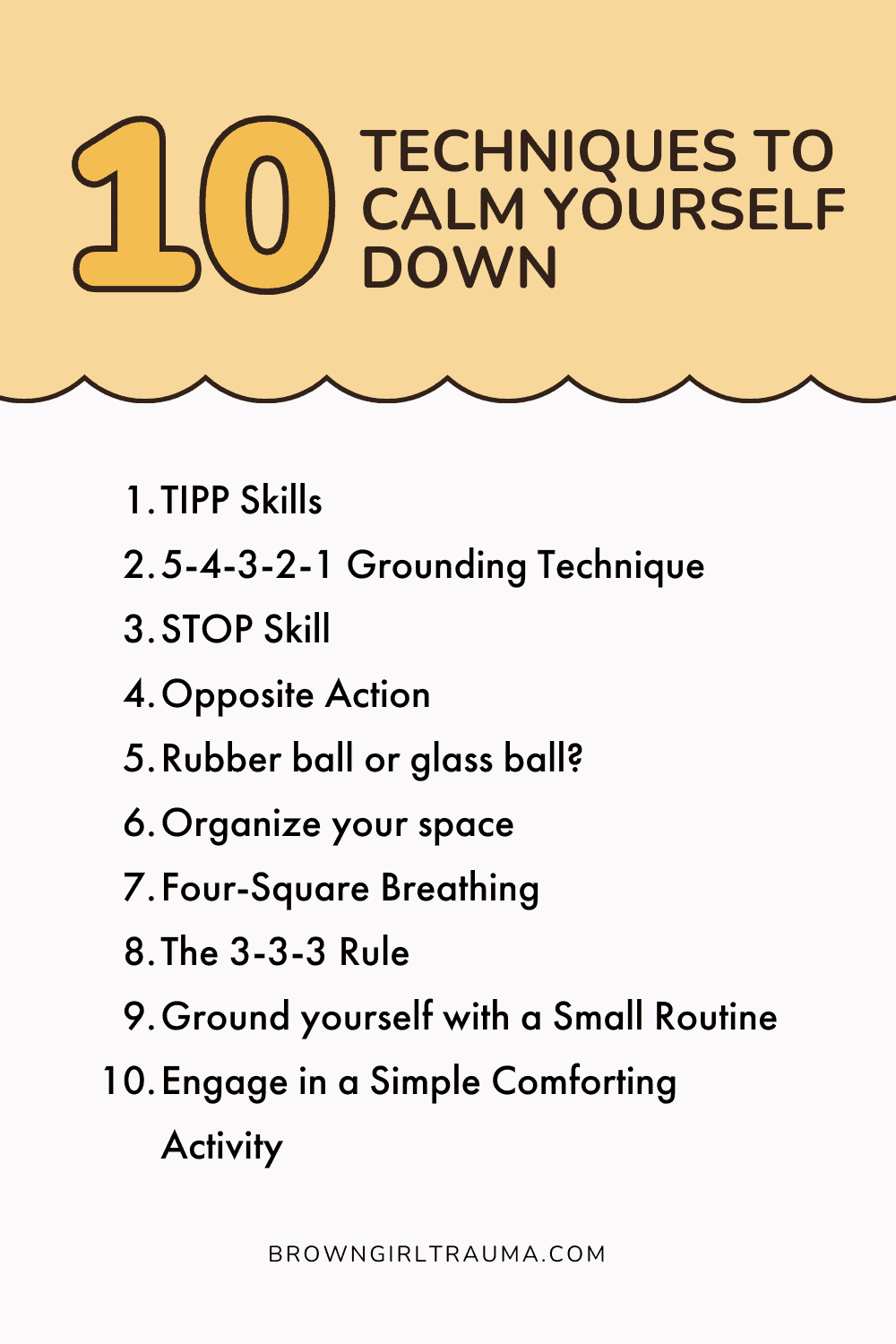5 Techniques to Calm Yourself Down Without Ignoring Your Feelings
Are you wondering how to calm yourself when your emotions are running high without pushing your feelings aside? For many people raised in a dysfunctional family, the calm state can feel like a balancing act of shutting down and blowing up.
If you can relate to this, don't be too hard on yourself; you learn, understand, and reenact what was modeled to you. But that is going to change today because I am going to teach you five techniques you can use to help center yourself and focus on the root of your feelings.

Alright, let's be honest: when you are so used to pushing your feelings aside to keep the peace in the family or relationship, you might have learned that 'calm' means tolerating, staying silent, avoiding conflict, or pretending that everything is okay.
But let me be the first one to tell you that feeling calm does not come from ignoring your feelings; it does quite the opposite. It bottles up how you are really feeling forcing it to come out in ways that can be harmful and problematic.
I am sure most of you have watched the movie Dear Zindagi, and this quote below captures why it's so hard to feel emotions like joy, happiness, love, etc., without pushing your feelings aside.
Bachchpan main jab rona aata hai, toh bade bolte hai aasun pocho. Jab gussa aata hai, toh bade kehte hai smile taaki ghar ki shanti bani rahe. Nafrat karna chahe, toh ijazat nahi di. Aur jab pyaar karna chaha, toh pata chala ye saala emotional system hi gadbada gaya, kaam nahi kar raha, cannot function.
Rona, gussa, nafrat kuch bhi khul ke express nahi karne diya. Ab pyaar kaise express kare?
In this blog post, I will share five simple and practical techniques for calming yourself when you need to manage overwhelming emotions. These are not quick fixes but rather tools to add to your coping toolbox, allowing you to explore ways to calm down that leave room for you to feel what's real. So grab your notebook and pen, and let's get started.
10 Techniques to Calm Yourself Down Without Ignoring Your Feelings
How to calm yourself down from anxiety
Anxiety can feel all-consuming, making it hard to feel in control of your own body. Most of us have watched the movie Inside Out 2, where we learn that anxiety is a necessary emotion that signs us to prepare for challenges, but it also shows us that when left unchecked, it can become overwhelming.
Learning to calm yourself when you are feeling anxious is about bringing your mind and body back into a more manageable state so you can approach things with clarity.
When you spend years managing others' emotions or trying to keep peace in the family, it's understandable that anxiety can become a part of your life. From walking on eggshells to trying to anticipate others' reactions, if your environment is often unpredictable, tense, or explosive, anxiety might feel like an ever-present undercurrent.
However, recognizing these triggers can empower you to take control of your anxiety, even in the face of small challenges that can make you feel on high alert and learn to navigate situations without feeling overwhelmed by old, automatic responses.
1. TIPP Skills (Temperature, Intense Exercise, Paced Breathing, Progressive Muscle Relaxation):
TIPP is a prevalent distress tolerance exercise designed to be used when your emotions are overwhelming. Think about the last time you felt really anxious- your heart rate increases, your thoughts racing, shallow breathing, and you might have felt impulsive urges. TIPP helps you bring that intensity down so you can regain control in the moment. Your first focus should be bringing down the intensity of the emotion, and that's exactly what this skill will help you with.
Temperature: Splash cold water on your face, dab an icepack to your face or chest, or dip your face into a cold bowl of ice water for 15-30 seconds to activate the dive reflex, which will help lower your heart rate and reduce your emotional intensity. The dive response is your brain thinking you are underwater, and to compensate, it will slow down your heart rate.
The sensation of cold water should not be painful, so monitor how your body feels and pull back if it becomes too uncomfortable.
Intense Exercise: Moving your body is a great way to release an emotion. Giving your body a quick burst of activity, like sprinting in place, jumping jacks, or having your own dance party, can help release pent-up energy. Of course, be mindful of your physical limitations and any health conditions by adjusting the intensity to what feels safe for you.
Paced Breathing: When you are feeling anxious, your thoughts and breathing are pretty rapid. You want to slow your breathing down by taking big breaths through your nose and exhaling for a longer period of time through your mouth. The longer exhale activates your body's calm system, the parasympathetic nervous system.
Progressive Muscle Relaxation: Take a deep breath and tense the muscles in your body, starting with the toes and then moving onto other muscle groups. Notice how the tension feels. When you take a deep breath out, let go of that tension and notice how your body feels when it is given the opportunity to relax.
2. 5-4-3-2-1 Grounding Technique with Five Senses
Think about a time you were feeling anxious. What was that experience like? Did you find your mind ruminating through worries and 'what-if' scenarios? Did you notice your body experiencing physical signs of anxiety, like shallow breathing, racing heart, and knots in your stomach?
This grounding technique with the five senses can help interrupt this loop by redirecting your attention to the immediate environment, away from anxious thoughts. When you engage in structured sensory activities, you help create space for your mind and body to relax without ignoring or suppressing your anxiety.
This technique involves engaging each of your five senses-sight, sound, smell, taste, and touch to ground yourself in the present moment. Here's how it works:
- Name five things you can see—Don't complicate it. Just look around and name five things in your immediate environment. These could be your coffee mug, a plant, or your favorite book.
- Name four things you can touch— Physically engage with things in your environment by feeling the textures.
- Name three things you can hear—Listen for distinct sounds in your environment, like soothing music, the hum of a fan, or the birds outside. Try to be fully present with those sounds.
- Two things you can smell— Light a candle or smell something comforting and really focus on the feeling it brings. I LOVE the smell of my coffee; it always puts a smile on my face.
- One thing you can taste—Take a bite of your favorite food or a sip of your chosen beverage and try to focus on the temperature, flavor, and texture.
Repeat this coping skill a few times as needed. The goal is to help you break the cycle of rumination that anxiety can cause and create space to calm yourself.
How to calm yourself down when angry
3. STOP Skill (Stop, Take a Step Back, Observe, Proceed Mindfully)
The STOP skill, a popular DBT coping strategy, helping you to prevent engaging or acting on impulsive reactions, giving you the control to respond rather than react when your anger is intense. When considering the use of STOP skills, envision a stop sign as your first cue to take a pause, reinforcing your control over your actions.
Stop: Visualize a stop sign and pause when you sense your anger escalating. The goal is to disrupt the automatic reaction, just as a stop sign halts traffic.
Take a step back: I have had clients physically take a step back and take a breath for this part of the skill. Whether you take a physical step or a mental one, the idea is to take a few breaths and allow yourself the opportunity to reset.
Observe: This step is about becoming acutely aware of what is happening within and around you. It's a way to identify the internal and external factors that are fueling your anger. When you scan your environment for triggers, pay attention to specific people, sounds, or situations that are exacerbating your frustration.
Turn inward and notice the physical, emotional, and cognitive responses. The goal is to acknowledge each sensation, feeling, and thought without categorizing it as positive or negative. You're simply gathering information about the elements that are intensifying your anger.
Proceed Mindfully: Once you understand how you feel, the next step is to choose your next step with awareness and intention. This might mean taking a break, walking away, communicating calmly, or using another situation that won't make the situation worse.
4. Opposite Action
Another effective way to calm yourself when you are angry is to use a technique called Opposite Action. When you are angry, you might have urges to yell, get defensive, get physical, argue, shut down, or isolate yourself. Opposite action encourages you to do the opposite of what your anger is asking you to do.
If you have the urge to snap at someone, take a moment to pause, breathe, and either express kindness or say nothing instead. If your anger makes you feel like getting physical, the opposite action helps you calm yourself by shifting that action urge into something non-harmful, like exercise, squeezing a stress ball, or moving your body to help you release the built-up energy. The easiest way is to think about the opposite of the urge behavior and try practicing that.
Opposite action does feel strange at first, especially if you are reactive with your emotions, but with practice, it will help you calm yourself by creating space between your feelings and reactions. The goal is to feel and process your emotions without letting them dictate your behavior.

How to calm yourself down when stressed or overwhelmed
5. Ask Yourself, 'Is it a rubber ball or glass ball?'
Do not underestimate the power of creating a to-do list in a world where there is always something that needs our attention. My husband, who learned this in the military, often reminds me of a helpful analogy: you have 'glass balls' and 'rubber balls.' The glass balls represent tasks like a work deadline or making a therapy appointment you cannot drop or miss. If you do, there can be consequences. Rubber balls are more flexible and can bounce back if you let them go temporarily, like cleaning your house.
When you feel overwhelmed or stressed, you may feel a bit out of control. When you start writing down things that are weighing on you and identify what things are on the list, are glass balls versus rubber balls? Picking 1-2 essential glass balls that you can realistically tackle today and that will help create an immediate sense of progress and control.
Asking yourself this question is a great way to help calm down by breaking down an out-of-control situation into more manageable steps.
6. Organize your space
I have come to realize that this is my go-to strategy when I am overwhelmed or feeling stressed. When you are overwhelmed or stressed out, mental clutter can make it hard to focus or feel at ease. A simple strategy to calm yourself is to take a few minutes to tidy up your space.
This does not mean you need to deep clean your entire house or room; rather, focus on one area of your space that you utilize the most and organize it.
When you organize your environment, you signal your mind that there is still some room for control. This helps slow down your racing thoughts and allows you to feel more centered. Think of this approach as using external order to gain internal calm, helping you slow down and feel a bit more organized.
How to calm yourself down when nervous
7. Box Breathing or Four-Square Breathing
Box breathing, a simple and effective technique for calming yourself by regulating your breathing, is a coping skill that can be easily followed and used anywhere.
Think of a square and trace the square by inhaling for a count of four seconds, holding your breath for four seconds, exhaling for four seconds, and pausing again for four seconds before repeating.
8. The 3-3-3 Rule
The 3-3-3 rule is another quick grounding exercise to use to help calm yourself when you are feeling nervous.
Look around and name three things you can see and three things you can hear, and move three parts of your body, like stretching your jaw, rolling your shoulders, or stretching your fingers. Repeat 3 times and switch up the order.
Similar to the 5-4-3-2-1 exercise, this technique will help you redirect your focus to the present moment and interrupt the flow of nervous thoughts, allowing you to feel more in control.
How to calm yourself down when sad
9. Ground yourself with a Small Routine
When you're feeling overwhelmed by sadness, a grounding routine can be your anchor, helping you regain a sense of stability. And the best part? It's a lot simpler than you might think. Whether it's making your bed, savoring your morning coffee, or taking a brief walk, these actions can provide a sense of structure and comfort in an otherwise tumultuous time.
I noticed that when I would get sad, I would do things that would make my emotions more intense, like watching a sad movie, listening to sad music, or emotionally eating. But when I started engaging in the opposite action of that, I noticed I was able to jump back quicker than ever.
For those of you raised in a dysfunctional family, you know firsthand the importance of a calming sense of control that reminds your brain you are safe and capable of handling the moment. When your emotional intensity is high, it can be harder to think about what might help if you don't already have a consistent routine, so a small way to start is by trying out a grounding activity.
10. Engage in a Simple Comforting Activity
Do you find engaging in a grounding routine too much? Don't worry—try engaging in a simple, comforting activity instead.
Wrap yourself in a warm blanket while watching a funny movie, journal your thoughts, or play with your pet to help yourself stay connected with your emotions while creating a nurturing environment to feel and release them.
You deserve to feel good, and by engaging in a simple, comforting activity, you can calm yourself while acknowledging that you might need some extra care and attention.
Learning to calm yourself is a step towards healing!
Learning to calm yourself is a skill that takes time and practice. Remember, the goal is progress, not perfection.
Every time you choose a more adaptive response to manage an emotion, you are moving towards healing. Noticing you did not do it perfectly but trying anyway is a movement toward healing. Extending self-compassion to yourself when you are not able to calm yourself in a healthy way is a movement toward healing.
As long as you are observing and trying, you heal a little more.
What is your favorite way to calm yourself? Share your go-to in the comments.
Psst...save these calming techniques to help you on your healing journey!

Want More Tools? These Posts Have You Covered!
60 Simple Healthy Coping Skills For Your Mental Health
15 Coping Skills for Anxiety You Need To Know Now
10 Practical Mental Health Goals For 2024 For Your Self-Growth
Nisha Patel
My name is Nisha Patel. I am a Licensed Clinical Social Worker and the face behind the space Brown Girl Trauma (BGT). BGT is a Mental Health and Self-Growth Community for Adult Children of Dysfunctional Families. The central question that drives my work is, “How can we break the cycle of family dysfunction?” To answer that question, I like to write about ways to reparent your inner child through healthy self-growth & mental health practices- addressing your unmet needs.

